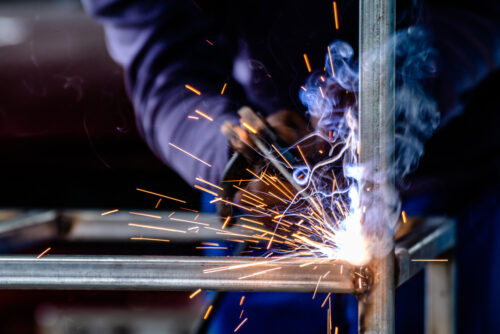Understanding the Various Sorts Of Welding Techniques and Services Readily Available

Overview of Welding Strategies
Welding methods include a diverse variety of techniques utilized to join materials together completely. One usual approach is arc welding, which includes producing an electric arc between the base and an electrode product to thaw and fuse them together. This method is flexible and can be used with various steels, making it one of the most widely made use of welding procedures.

Furthermore, TIG welding, or Gas Tungsten Arc Welding (GTAW), is a clean and exact welding approach that makes use of a non-consumable tungsten electrode to develop the weld. TIG welding is typically made use of for thinner materials and gives exceptional control over the welding procedure. In general, comprehending these numerous welding methods is vital for picking the most suitable technique for various projects.
Commonly Used Welding Techniques
A series of typically made use of approaches are used in the field of welding to successfully sign up with materials with each other. One of the most commonly utilized methods is Gas Metal Arc Welding (GMAW), likewise recognized as MIG welding. This approach uses a cord electrode that is fed via a welding gun, along with a protecting gas to secure the weld from impurities airborne. Another common technique is Secured Steel Arc Welding (SMAW), or stick welding, which makes use of a flux-coated electrode to produce the weld. Tungsten Inert Gas (TIG) welding is preferred for its accuracy and convenience, making use of a non-consumable tungsten electrode to generate the weld. Flux-Cored Arc Welding (FCAW) is generally made use of in industrial setups due to its high welding speed and mobility. Furthermore, Submerged Arc Welding (SAW) is ideal for developing deep welds on thick materials. These frequently used welding approaches provide to various demands and materials, providing choices for various welding applications.
Advanced Welding Solutions
Structure upon the structure of commonly utilized welding approaches, the realm of sophisticated welding solutions includes cutting-edge techniques and modern technologies that push the limits of accuracy and efficiency in product joining processes. Advanced welding services often include specialized approaches such as laser welding, electron beam welding, and friction stir welding. Laser welding uses a highly focused beam to exactly join metals with very little heat-affected areas, making it suitable for complicated or delicate components. Electron light beam welding, on the various other hand, employs a high-velocity electron beam to produce deep weld infiltrations in products like aerospace alloys or different metals. Rubbing stir welding, a solid-state joining procedure, enables the welding of products that are testing to fuse utilizing traditional techniques, like aluminum and copper. These advanced methods provide boosted control over the welding process, causing stronger, extra sturdy welds with decreased distortion and boosted general high quality.
Specialized Welding Techniques

Another specialized welding method is laser beam of light welding, where a very concentrated beam of light is made use of to sign up with metals with marginal heat-affected zones and distortion. This method is frequently used in sectors requiring high precision and sanitation, such as electronics and clinical tool manufacturing. In addition, explosive welding is a special strategy that uses controlled nitroglycerins to bond dissimilar steels together, creating trustworthy and strong joints. These specialized welding methods showcase the diversity and technology present in the field of welding, supplying options for a vast array of commercial applications.

Selecting the Right Welding Refine
Selecting the proper welding process is extremely important in accomplishing optimal cause steel manufacture and signing up with procedures. With various welding methods readily available, it is important to consider elements such as the sort of steel, density, joint layout, and wanted outcome when selecting the ideal welding procedure - Welding Inspection Service. Amongst the usual welding techniques are Gas Metal Arc Welding (GMAW), Shielded Metal Arc Welding (SMAW), Gas Tungsten Arc Welding (GTAW), and Flux-Cored Arc Welding (FCAW) GMAW, also recognized as MIG welding, appropriates for More Info welding thin to thick steels and is versatile in different positions. On the other hand, SMAW, or stick welding, is a reliable approach for outdoor and area welding due to its transportability and simplicity. GTAW, or TIG welding, is ideal for welding thin materials and provides precise and premium welds. FCAW is chosen for welding thick products and is recognized for its high welding speeds. Understanding the qualities of each welding process is important in choosing one of the most ideal method for a certain welding project.
Conclusion
To conclude, understanding the numerous kinds of welding strategies and services offered is important for picking the right method for a specific task. By knowing the commonly made use of welding methods, advanced welding services, and specialized techniques, people can make enlightened choices to make sure the success of their welding jobs. It is vital to take into consideration variables such as materials, job needs, and budget plan when picking one of the most ideal welding process.
From conventional methods like stick welding to innovative procedures such as laser welding, the globe of welding provides a multitude of choices for signing up with steels together.Furthermore, TIG welding, or Gas Tungsten Arc Welding (GTAW), is a tidy and specific welding method that utilizes a non-consumable tungsten electrode to produce the weld. Advanced welding services commonly entail specialized techniques such as laser welding, electron beam of light welding, and rubbing mix welding. Among the usual welding approaches are Gas Metal Arc Welding (GMAW), Protected Steel Arc Welding (SMAW), Gas Tungsten Arc Welding (GTAW), and Flux-Cored check this Arc Welding (FCAW) By being aware of the commonly used welding approaches, progressed welding solutions, and specialized strategies, people can make educated decisions to make sure the success of their welding projects.
Comments on “Dependable Welding Inspection Service for Quality Assurance”